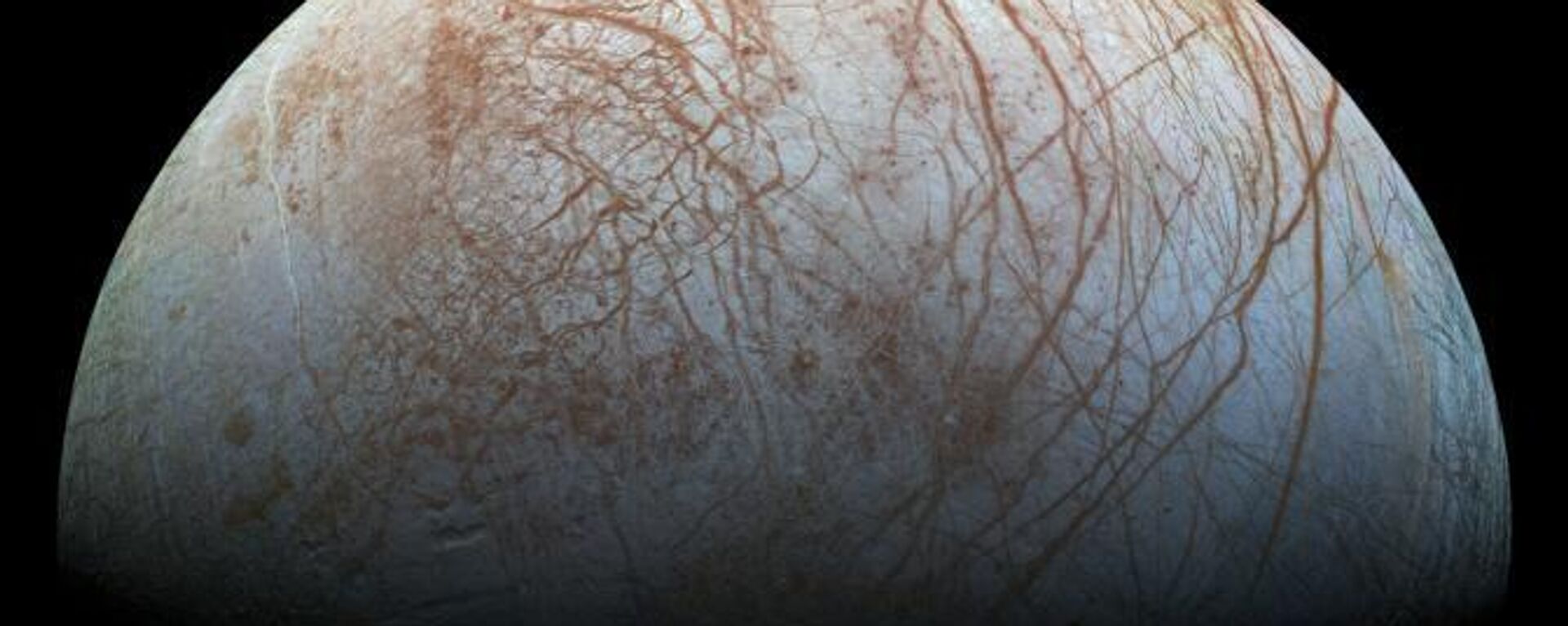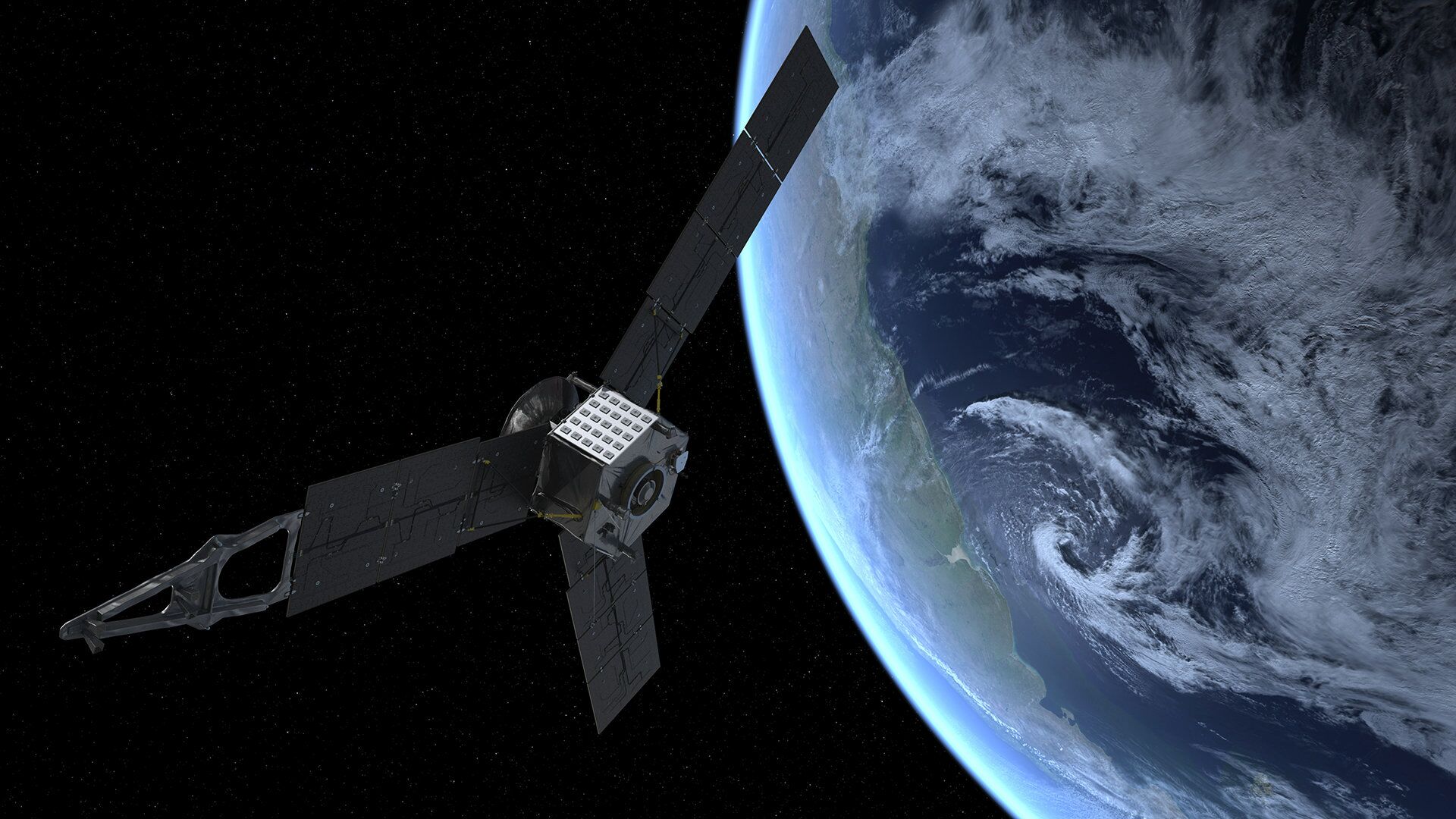https://sputnikglobe.com/20240311/does-life-exist-on-jupiters-moon-new-data-may-be-getting-closer-to-answer-1117263485.html
Does Life Exist on Jupiter’s Moon? New Data May Be Getting Closer to Answer
Does Life Exist on Jupiter’s Moon? New Data May Be Getting Closer to Answer
Sputnik International
Europa, one of Jupiter's largest moons, produces insufficient oxygen to sustain life.
2024-03-11T15:30+0000
2024-03-11T15:30+0000
2024-03-11T15:30+0000
beyond politics
princeton university
florida institute of technology
europa
nasa
jupiter
earth
kevin hand
newsfeed
society
https://cdn1.img.sputnikglobe.com/img/18403/71/184037171_0:0:1920:1080_1920x0_80_0_0_d4afbd16ea3b229ec58422aa8dd5f035.jpg
Recent data from NASA's Juno spacecraft, which orbits Jupiter, suggests that if anything is concealed within the depths of this moon's shadow, it may lack oxygen. The discovery, published in Nature Astronomy, was based on analysis of data transmitted by NASA’s Juno spacecraft while orbiting Jupiter during a quick flyby in September 2022.Jamey Szalay and his research team at Princeton University concluded that while the moon's surface releases hydrogen abundantly, it only produces a mere 18 kilograms of oxygen per second.This falls significantly short of the approximately 1,000 kilograms per second predicted by previous computer models.Despite this shortfall, recent oxygen estimates "are still compatible with microbial habitability for life as we know it," noted astrobiologist Manasvi Lingam of the Florida Institute of Technology, who was not involved in the study.Water bodies buried beneath Europa's surface are assumed to be nutrient-deficient due to their isolation and the absence of sunlight, which powers photosynthesis.But nutrients stockpiled on the oceans' ice-covered rooves over hundreds of millions of years could have been transported by several geological processes to greater depths below. The scarcity of sunlight is "not necessarily a death knell for life in subsurface oceans," remarked Lingam.Europa's atmosphere has a delicate layer of oxygen hugging the moon's surface under a thicker layer of hydrogen. Hydrogen and oxygen continuously replenish the moon's thin air as they escape its radiation-filled icy shell. Szalay explains that these elements are “bouncing around...every once in a while, one of them pops off."During Juno’s few minutes flypast of Europa, its JADE (Jovian Auroral Distributions Experiment) instrument detected free hydrogen atoms within the moon’s environs. It calculated 100 million atoms during its short passage. The Princeton team reverse-engineered how much oxygen is dissipated on the moon's surface and then determined the quantity of oxygen it produces. According to research co-author and JADE instrument lead Frederic Allegrini of the Southwest Research Institute in Texas, means “there’s no doubt that they come from Europa.”Kevin Hand from NASA's Jet Propulsion Laboratory, a scientist not part of the recent research, has lauded the latest findings as “very intriguing”. “But oxygen is only part of the story,” he said.Hand’s earlier study with his team revealed that the yellowish-brown material covering much of Europa's surface is salt, suggesting the presence of hydrothermal vents on the moon’s seafloor. That raises the possibility of an energy source that could foster microorganisms like on our planet.Hands and his colleagues also confirmed parts of Europa’s frosty shell are rich in Epsom salt. Earth’s microbial life “loves to chew away on sulfate.” The sulfate on the surface implies that it could also seep into Europa's ocean, significantly enhancing its habitability.Life on Earth likely emerged around four billion years ago. On theory says life could have begun at hydrothermal vents on the seafloor, supplying energy that formed complex organic molecules. Our planet was oxygen-starved for the first half of its existence. The emergence of Earth's atmospheric oxygen is attributed to the evolution of cyanobacteria, capable of oxygen-producing photosynthesis, around two billion years ago.Astrobiologists are gearing up for NASA's Europa Clipper mission scheduled for 2030, following Juno into an orbit near Jupiter. Like Juno, Clipper will avoid orbiting Europa to escape Jupiter's intense radiation belts. It will circle the gas giant while making around 50 flybys of the moon over four years.That mission aims to map Europa's interior and assess its subsurface ocean depth, potentially measuring oxygen abundance just 25 kilometers above its icy surface.
https://sputnikglobe.com/20230922/scientists-find-carbon-on-jupiters-moon-europa-raising-questions-about-habitability-1113595323.html
https://sputnikglobe.com/20231103/salts-organic-compounds-discovered-on-jupiters-ocean-moon-ganymede-1114703599.html
europa
jupiter
earth
Sputnik International
feedback@sputniknews.com
+74956456601
MIA „Rossiya Segodnya“
2024
Chimauchem Nwosu
https://cdn1.img.sputnikglobe.com/img/07e7/09/01/1113046371_0:99:1536:1635_100x100_80_0_0_9c5c627283eca931c39fe4852bbb301c.jpg
Chimauchem Nwosu
https://cdn1.img.sputnikglobe.com/img/07e7/09/01/1113046371_0:99:1536:1635_100x100_80_0_0_9c5c627283eca931c39fe4852bbb301c.jpg
News
en_EN
Sputnik International
feedback@sputniknews.com
+74956456601
MIA „Rossiya Segodnya“
Sputnik International
feedback@sputniknews.com
+74956456601
MIA „Rossiya Segodnya“
Chimauchem Nwosu
https://cdn1.img.sputnikglobe.com/img/07e7/09/01/1113046371_0:99:1536:1635_100x100_80_0_0_9c5c627283eca931c39fe4852bbb301c.jpg
jupiter's largest moons, europa, nasa's juno spacecraft, jovian auroral distributions experiment, jade, epsom salt, table salt on europa, europa flybys, europa's ocean, microbial habitability for life on europa.
jupiter's largest moons, europa, nasa's juno spacecraft, jovian auroral distributions experiment, jade, epsom salt, table salt on europa, europa flybys, europa's ocean, microbial habitability for life on europa.
Does Life Exist on Jupiter’s Moon? New Data May Be Getting Closer to Answer
Europa, one of Jupiter's largest moons, produces insufficient oxygen to sustain life.
Recent data from NASA's Juno spacecraft, which orbits Jupiter, suggests that if anything is concealed within the depths of this moon's shadow, it may lack oxygen.
The discovery, published in
Nature Astronomy, was based on analysis of data transmitted by NASA’s Juno spacecraft while orbiting Jupiter during a quick flyby in September 2022.
Jamey Szalay and his research team at Princeton University concluded that while the moon's surface releases hydrogen abundantly, it only produces a mere 18 kilograms of oxygen per second.
This falls significantly short of the approximately 1,000 kilograms per second predicted by previous computer models.
Despite this shortfall, recent oxygen estimates "are still compatible with microbial habitability for life as we know it," noted astrobiologist Manasvi Lingam of the Florida Institute of Technology, who was not involved in the study.

22 September 2023, 22:58 GMT
Water bodies buried beneath Europa's surface are assumed to be nutrient-deficient due to their isolation and the absence of sunlight, which powers photosynthesis.
But nutrients stockpiled on the oceans' ice-covered rooves over hundreds of millions of years could have been transported by several geological processes to greater depths below. The scarcity of sunlight is "not necessarily a death knell for life in subsurface oceans," remarked Lingam.
Europa's atmosphere has a delicate layer of oxygen hugging the moon's surface under a thicker layer of hydrogen. Hydrogen and oxygen continuously replenish the moon's thin air as they escape its radiation-filled icy shell. Szalay explains that these elements are “bouncing around...every once in a while, one of them pops off."
During Juno’s few minutes flypast of Europa, its JADE (Jovian Auroral Distributions Experiment) instrument detected free hydrogen atoms within the moon’s environs. It calculated 100 million atoms during its short passage.
The Princeton team reverse-engineered how much oxygen is dissipated on the moon's surface and then determined the quantity of oxygen it produces. According to research co-author and JADE instrument lead Frederic Allegrini of the Southwest Research Institute in Texas, means “there’s no doubt that they come from Europa.”
Kevin Hand from NASA's Jet Propulsion Laboratory, a scientist not part of the recent research, has lauded the latest findings as “very intriguing”.
“But oxygen is only part of the story,” he said.
Hand’s earlier study with his team revealed that the yellowish-brown material covering much of Europa's surface is salt, suggesting the presence of hydrothermal vents on the moon’s seafloor. That raises the possibility of an energy source that could foster microorganisms like on our planet.
Hands and his colleagues also confirmed parts of Europa’s frosty shell are rich in Epsom salt. Earth’s microbial life “loves to chew away on sulfate.” The sulfate on the surface implies that it could also seep into Europa's ocean, significantly enhancing its habitability.

3 November 2023, 21:11 GMT
Life on Earth likely emerged around four billion years ago. On theory says life could have begun at hydrothermal vents on the seafloor, supplying energy that formed complex organic molecules.
Our planet was oxygen-starved for the first half of its existence. The emergence of Earth's atmospheric oxygen is attributed to the evolution of cyanobacteria, capable of oxygen-producing photosynthesis, around two billion years ago.
Astrobiologists are gearing up for NASA's Europa Clipper mission scheduled for 2030, following Juno into an orbit near Jupiter. Like Juno, Clipper will avoid orbiting Europa to escape Jupiter's intense radiation belts. It will circle the gas giant while making around 50 flybys of the moon over four years.
That mission aims to map Europa's interior and assess its subsurface ocean depth, potentially measuring oxygen abundance just 25 kilometers above its icy surface.





